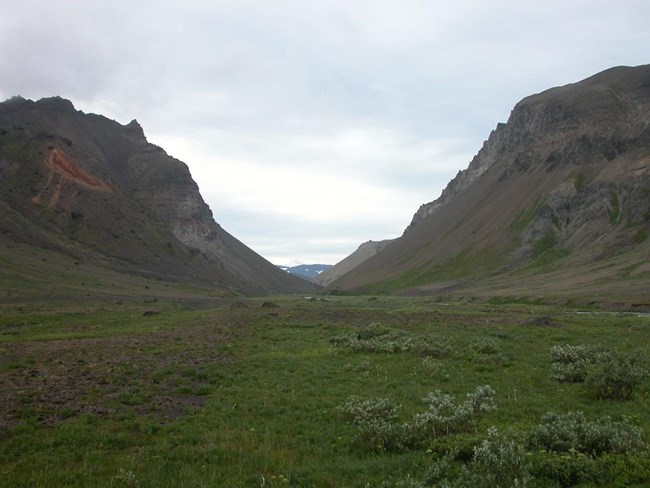
Climate
Aniakchak National Monument and Preserve’s climate is cool, windy, and wet. It is bordered on the east by the North Pacific and on the west by Bristol Bay. With most storms originating in the Gulf of Alaska, the eastern half is characterized by high precipitation and moderate temperatures, while the western half is characterized by lower precipitation, often foggy summer days, and wider temperature ranges. Weather in the caldera is affected by air masses that move in from the North Pacific and Bering Seas, low cloud ceilings, rain, and high winds are common, even when the weather is relatively calm outside.
Geology
Although dominated by volcanism, scattered Pleistocene glacial deposits occur within the monument, and Jurassic and Cretaceous sedimentary formations of sandstone, shale, conglomerate and limestone are also present. In 2002, fossilized hadrosaur tracks were found.
Aniakchak has erupted at least 40 times in the past 10,000 years, with the most recent eruption occurring in 1931. Ancestral Aniakchak Volcano underwent a catastrophic explosive eruption about 3,400 years ago, forming Aniakchak Caldera and blanketing much of the surrounding landscape with thick, fast-moving pyroclastic flows. Post-formation volcanic activity within the caldera has resulted in the emplacement of numerous lava domes, maars, eruptions pits, and lava flows.
Hydrology
Surprise Lake, a large (660 ac or 267 ha) lake located along the northeast edge of the caldera floor, drains 80% of the caldera and is fed by 11 surface inlets and numerous warm and cold springs. The Aniakchak River heads eastward from Surprise Lake, drops steeply out of the caldera, through an area known as "the Gates," and then flows through a broad valley to Aniakchak Bay. Despite its small volume and relatively short length, the Aniakchak River is the largest stream on the Alaska Peninsula draining into the Pacific Ocean.
Meshik Lake, at 66 ac (26 ha), lies southeast of the caldera and is fed by wetlands and small, steep drainages from Pinnacle Mountain. The Meshik River, originating at Meshik Lake, flows southwest and discharges into Bristol Bay near Port Heiden. Many of its tributaries drain the south side of the caldera.
Flora and Fauna
Large expanses of cinder and tephra plains surround the crater itself. This area is largely barren, with scattered willows and forbs occupying the edges of blowouts and lower drainages. Inside the caldera, wet herb and sedge meadows are concentrated near the outlet and the northwest end of Surprise Lake. Patches of willow, bluejoint, and crowberry heath are found on the rolling, lower-elevation slopes of old lava flows, while steeper and more wind-exposed areas remain unvegetated.
The Cinder River drainage has a few isolated cottonwood trees, relatively lush willow stands, and grass/forb meadows with patches of crowberry heath or wetlands. Alder patches grow in the valleys above the cinder plains. The upper Meshik River valley is dominated by wetlands. Willow and alder thickets occur near Meshik Lake and along the Meshik River. Coastal headlands are dominated by bluejoint and forb meadows, alder patches, and crowberry heath.
Documented freshwater fish diversity is low, but a substantial intertidal zone in the Aniakchak River suggests that there is probably significant transient marine diversity. All five species of Pacific salmon are present, and Dolly Varden or Arctic char occur in most streams.
Thirty terrestrial mammal species are documented or are expected to occur in the park. Some of the more commonly observed species include brown bear, moose, caribou, red fox, Arctic ground squirrel, and tundra vole. Species less frequently observed include wolf, river otter, wolverine, porcupine, and beaver. Information on the distribution, abundance, and breeding status of most terrestrial mammals in Aniakchak is limited.
One hundred and twenty-nine bird species are documented or expected to occur here, including 47 landbird species, 47 inland waterbird species, and 35 seabird species. Information on bird species largely consists of anecdotal sightings noted by NPS rangers and resource management staff.
Currently no federally listed species are known to occur in Aniakchak. Harlequin Duck, which occur in freshwater areas, are a species of concern, a designation that indicates that further research is needed to assess biological vulnerability, taxonomy, and threats. Lynx, also a species of concern, are at the southern boundary of their range in Aniakchak and sightings are rare.
Inventories have been completed for birds, fish, vascular plants, water quality, and soils in Aniakchak. No monitoring is currently conducted in Aniakchak due to safety and cost considerations related to its remote location and inclement weather.
What's Happening in Aniakchak National Monument and Preserve
Last updated: December 20, 2023
